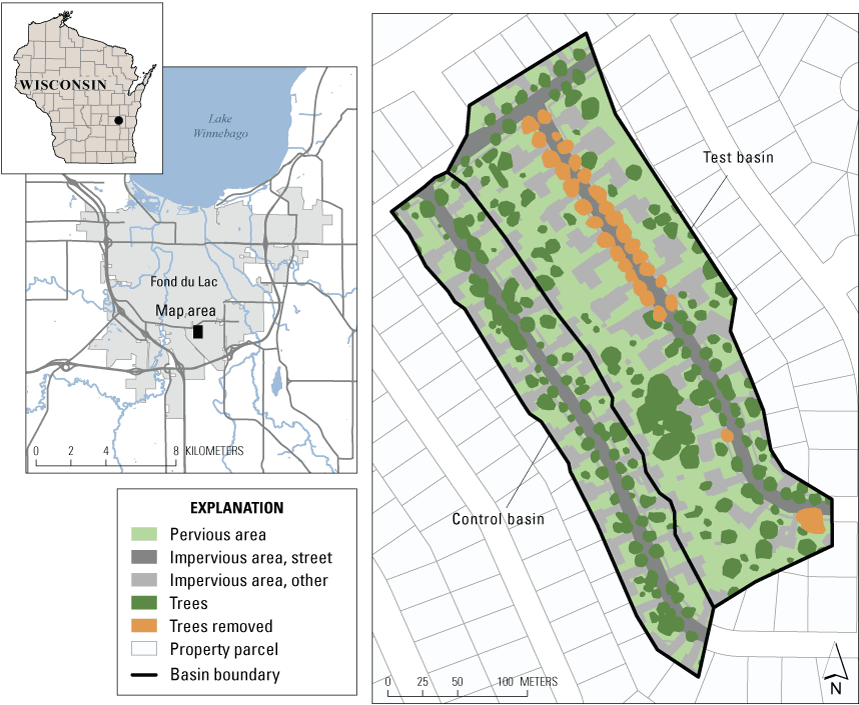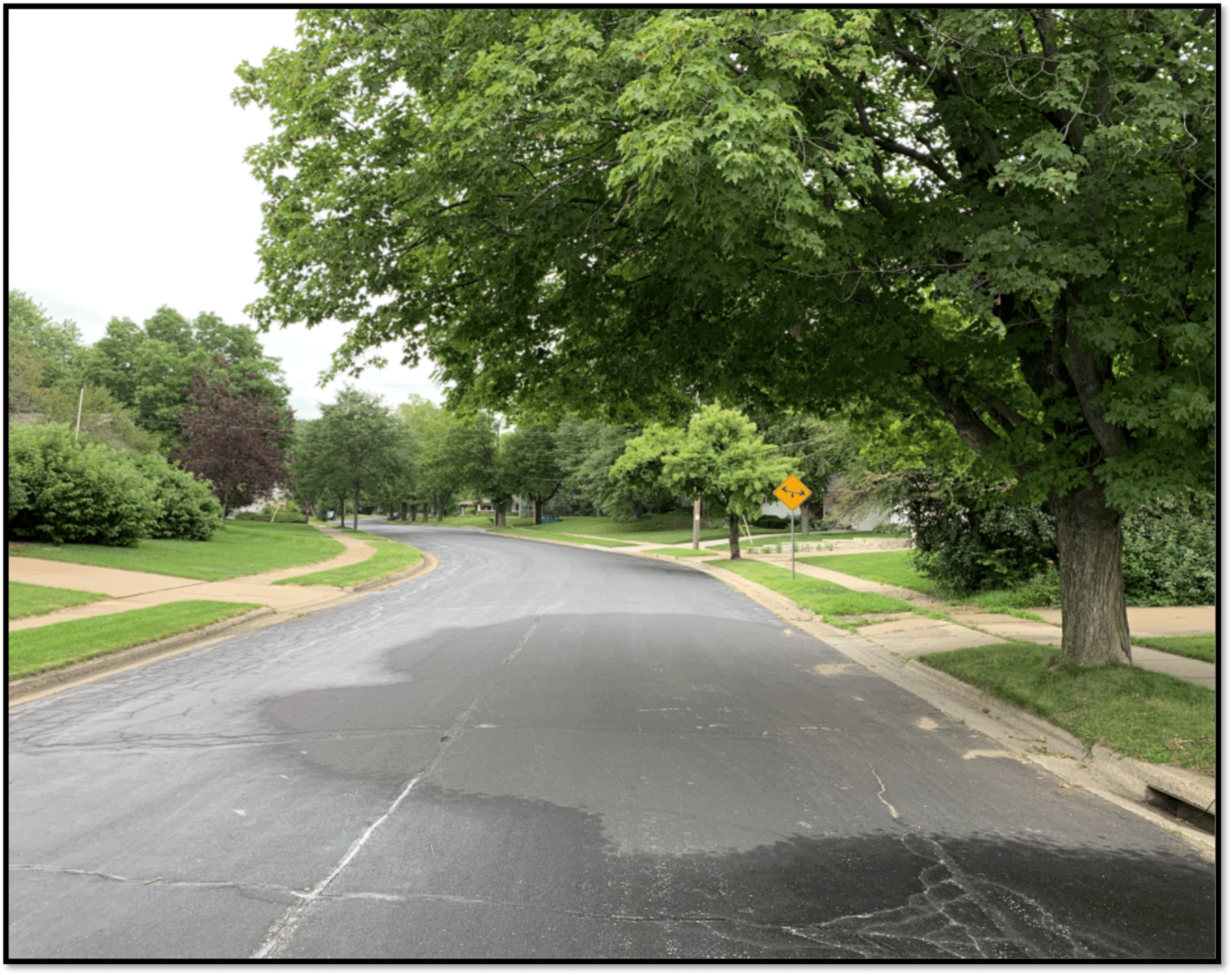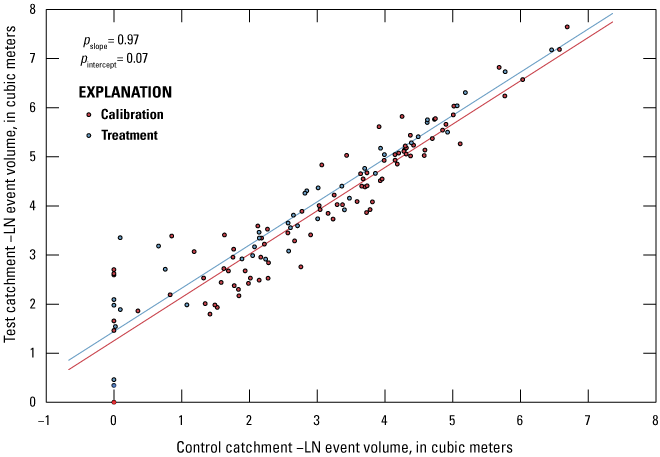Loss of Street Tree Canopy Increases Stormwater Runoff
Links
- Document: Report (1.97 MB pdf) , HTML , XML
- Download citation as: RIS | Dublin Core
Introduction
Urban forests have largely been overlooked for the role they play in reducing stormwater runoff volume by using hydrologic processes such as interception (rainfall intercepted by tree canopy), evapotranspiration (the transfer of water from vegetation into the atmosphere) and infiltration (percolation of rainwater into the Earth’s soil). Early research into the effects of trees on urban stormwater runoff used simple estimates based on assumptions of canopy coverage and design storm criteria. In a review of available literature on how capable urban trees are at reducing runoff, the Center for Watershed Protection (2017) found only six studies; three of them used measured data from a single plot, and the other three used models. When identifying gaps in research on the role of trees in stormwater management, Kuehler and others (2017) highlighted the need for studies that scale the local effects of urban trees to the larger sewershed catchment area, allowing a more holistic understanding of the urban tree canopy effects on hydrology.
For these reasons, the U.S. Geological Survey, in cooperation with the U.S. Environmental Protection Agency, U.S. Forest Service, and the University of Wisconsin, quantified the effect of removing urban street trees and their canopy on stormwater generation in a medium-density residential area. Using a paired-catchment experimental design, rainfall-runoff relations were characterized in two medium-density residential catchments in Fond du Lac, Wisconsin (fig. 1), during May through September in 2018–20. Results of the study are detailed in Selbig and others (2022).
During the calibration phase, hydrograph metrics from paired runoff events were used to develop the relation between the control and test catchments with street trees in place. The ability to measure changes to the rainfall-runoff response after removal of tree canopy was made possible by an aggressive tree removal program by the city as a response to rapid infestation from the Agrilus planipennis (emerald ash borer). In March 2020, a total of 31 street trees were removed at the onset of the treatment period, resulting in a loss of 2,990 square meters of canopy over streets, driveways, sidewalks, and grassed areas.

Control and test basins in the Lake Michigan drainage basin, Fond du Lac, Wisconsin. [Canopy area for trees was determined using geographic information system software and aerial photographs during leaf maturation.]
Umbrella or Funnel?
Street trees differ from their counterparts in rural forests because they are usually grown in open areas and have low species diversity (Ma and others, 2020). For this reason, street trees face less competition for water and sunlight resulting in large crown and leaf surface areas (Xiao and McPherson, 2002). Trees are, therefore, important components of the urban water cycle, which affects the runoff response in these urbanized catchments. Tree canopy can serve as an umbrella by intercepting most of the precipitation until the storage capacity of leaves is exceeded (fig. 2). At that point, precipitation passes through the canopy as throughfall or moves down the limbs and trunk as stemflow. Water can also collect near the “elbows” of limbs and branches that funnel runoff to pervious or impervious surfaces below.

Light precipitation is intercepted by the canopy of a street tree in a residential neighborhood in Fond du Lac, Wisconsin.
Changes in Stormwater Runoff After Tree Removal
A total of 134 warm-season precipitation events, each with precipitation depths greater than 0.5 millimeter were measured over a 15-month span. Quantification of the overall efficiency of street tree canopy revealed an increase in stormwater runoff volume after street trees were removed, as indicated by an upward vertical shift in the treatment trendline (fig. 3). Although intercepts between the calibration and treatment phase were significantly different, events that produced no runoff potentially affected the resulting trendline. For this reason, paired event volumes were discretized into smaller precipitation ranges to better understand the reductive effect tree canopy has across an array of depths. Precipitation ranges detailed in table 1 were selected to provide granularity across the full range of depths while maintaining a similar number of events within each range during the treatment period. Only two of the five precipitation ranges had significant changes in slope and intercept (p-value less than or equal to 0.10) (table 1).

Trend of stormwater runoff volume in the test and control basins, Fond du Lac, Wisconsin. [LN, natural logarithm]
Table 1.
Percent changes in stormwater runoff volume across a gradient of precipitation ranges after street trees were removed.[mm, millimeter; ≤, less than or equal to; --, not significant; ≥, greater than or equal to]
The volumetric increase for the 12.46–25.15 millimeter range during the treatment period was 153 cubic meters (m3) (table 2). An additional increase of 45 m3 was estimated for the 2.55–6.10 millimeter precipitation range, the only other precipitation range that was statistically significant. These two ranges, when combined, accounted for an increase of 198 m3, which was equivalent to 4 percent of the total runoff volume measured in the test catchment during the treatment period. An increase in runoff volume of 198 m3 indicates the volume reduction capacity of the removed canopy was 66 liters per square meter over the 42 storms during May through September 2020. Together these values represent the cumulative effect on stormwater generation from changes (interception, evapotranspiration, and infiltration) that are associated with removing mature street trees from the test catchment.
Table 2.
Estimated increase in stormwater runoff volume through removal of street tree canopy in the test catchment during the treatment period.[Estimates are based on the difference between the sum of predicted and observed event volumes for each precipitation range. mm, millimeter; m3, cubic meter]
Implications for Stormwater Management
The diversity of street trees in the test catchment was limited to the Acer and Fraxinus genera, which are the two most common street trees found in the Midwest (Ma and others, 2020). Although the runoff reduction volumetric benefits reported in this study reflect only Fraxinus pennsylvanica (green ash), a review of leaf area index shows the Fraxinus genus to be a good average representation of the diverse species of urban street trees commonly used in the Midwest (Ma and others, 2020). With an estimated 17 million trees at risk of replacement in the central and eastern United States because of infestation (Kovacs and others, 2010), more stormwater runoff is likely to reach receiving waters as street tree canopy is gradually removed. Understanding the value of urban tree canopy as a tool for stormwater management can help cities assess how removal and subsequent planting of street trees may affect the volume of stormwater runoff.
References Cited
Center for Watershed Protection, 2017, Review of the available literature and data on the runoff and pollutant removal capabilities of urban trees (ver. 1.1, December 2017): Ellicott City, Md., Center for Watershed Protection Inc., 42 p., accessed April 7, 2021, at https://owl.cwp.org/mdocs-posts/review-of-the-available-literature-and-data-on-the-runoff-and-pollutant-removal-capabilities-of-urban-trees/.
Kovacs, K.F., Haight, R.G., McCullough, D.G., Mercader, R.J., Siegert, N.W., and Liebhold, A.M., 2010, Cost of potential emerald ash borer damage in U.S. communities, 2009–2019: Ecological Economics, v. 69, no. 3, p. 569–578. [Also available at https://doi.org/10.1016/j.ecolecon.2009.09.004.]
Kuehler, E., Hathaway, J., and Tirpak, A., 2017, Quantifying the benefits of urban forest systems as a component of the green infrastructure stormwater treatment network: Ecohydrology, v. 10, no. 3, p. e1813. [Also available at https://doi.org/10.1002/eco.1813.]
Ma, B., Hauer, R.J., Wei, H., Koeser, A.K., Peterson, W., Simons, K., Timilsina, N., Werner, L.P., and Xu, C., 2020, An Assessment of Street Tree Diversity—Findings and Implications in the United States: Urban Forestry & Urban Greening, v. 56, p. 126826. [Also available at https://doi.org/10.1016/j.ufug.2020.126826.]
Selbig, W.R., Loheide, S.P., Shuster, W., Scharenbroch, B.C., Coville, R.C., Kruegler, J., Avery, W., Haefner, R., and Nowak, D., 2022, Quantifying the stormwater runoff volume reduction benefits of urban street tree canopy: Science of the Total Environment, v. 806, p. 151296. [Also available at https://doi.org/10.1016/j.scitotenv.2021.151296.]
Xiao, Q.F., and McPherson, E.G., 2002, Rainfall interception by Santa Monica’s municipal urban forest: Urban Ecosystems, v. 6, no. 4, p. 291–302. [Also available at https://doi.org/10.1023/B:UECO.0000004828.05143.67.]
For additional information, contact:
Director, USGS Upper Midwest Water Science Center
1 Gifford Pinchot Drive
Madison, WI 53726
608–828–9901
https://www.usgs.gov/centers/upper-midwest-water-science-center
Disclaimers
Any use of trade, firm, or product names is for descriptive purposes only and does not imply endorsement by the U.S. Government.
Although this information product, for the most part, is in the public domain, it also may contain copyrighted materials as noted in the text. Permission to reproduce copyrighted items must be secured from the copyright owner.
Suggested Citation
Selbig, W.R., Loheide, S.P., II, Shuster, W., Scharenbroch, B.C., Coville, R.C., Kruegler, J., Avery, W., Haefner, R., and Nowak, D., 2022, Loss of street tree canopy increases stormwater runoff: U.S. Geological Survey Fact Sheet 2022–3074, 4 p., https://doi.org/10.3133/fs20223074.
ISSN: 2327-6932 (online)
Study Area
| Publication type | Report |
|---|---|
| Publication Subtype | USGS Numbered Series |
| Title | Loss of street tree canopy increases stormwater runoff |
| Series title | Fact Sheet |
| Series number | 2022-3074 |
| DOI | 10.3133/fs20223074 |
| Publication Date | September 21, 2022 |
| Year Published | 2022 |
| Language | English |
| Publisher | U.S. Geological Survey |
| Publisher location | Reston, VA |
| Contributing office(s) | Upper Midwest Water Science Center |
| Description | 4 p. |
| Country | United States |
| State | Wisconsin |
| City | Fond du Lac |
| Online Only (Y/N) | Y |


